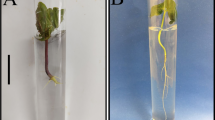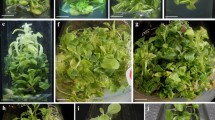Abstract
In present study, the effect of lanthanum (La) on the rooting of regenerated shoots of Saussurea involucrata Kar. et Kir was analyzed. Rooting occurred from regenerated shoots inoculated on a medium supplemented with La, the plant rooting hormone indole-3-acetic acid (IAA), or both La and IAA together. The highest rooting efficiency (96%), root number/shoot (8.5), and root length (63 mm) were recorded in shoots cultured on medium containing 2.5 μM IAA combined with 100 μM La3+. In order to elucidate the mechanism of rooting enhancement by La, we examined dynamic changes in antioxidant enzyme activities in plant tissue over time in culture. We found that the activities of peroxidase (POX) and superoxide dismutase (SOD) were significantly higher in plant tissue cultured in IAA plus La than in La or IAA alone. At the same time, the highest H2O2 content was detected in plant tissue in the presence of 2.5 μM IAA plus 100 μM La3+. In light of these data and previous results, we speculate that La enhanced IAA-induced rooting by acting as a mild abiotic stress to stimulate POX and SOD activities in plant cells. Then, IAA reacted with oxygen and POX to form the ternary complex enzyme–IAA–O2 that dissociated into IAA radicals and O –2 . Subsequently, IAA-induced O –2 readily converted to hydroxyl radical (HO·) via SOD-catalyzed dismutation. Finally, cell wall loosening and cell elongation occurred as a consequence of HO-dependent scission of wall components, leading to root growth. The treatment of IAA combined with La resulted in the highest plantlet survival (80%) compared to single treatments with IAA or La alone. These data suggest that rare earth elements enhance root morphogenesis and the growth of S. involucrata.


Similar content being viewed by others
References
Hu Z, Richter H, Sparovek G, Schnug E (2004) Physiological and biochemical effects of rare earth elements on plants and their agricultural significance: a review. J Plant Nutr 27:183–220
Hong FS, Wei ZG, Zhao GW (2002) Mechanism of lanthanum effect on the chlorophyll of spinach. Sci China Ser C 45(2):166–176
Weiping S, Fashui H, Zhigang W, Yuzhen Z, Fugen G, Hongoing X, Mingliang Y, Youhong C, Mizhen Z, Jiale S (2003) Effects of cerium on nitrogen metabolism of peach plantlet in vitro. Biol Trace Elem Res 95:259–268
Pfeiffer W, Hoftberger M (2001) Oxidative burst in Chenopodium rubrum suspension cells: induction by auxin and osmotic changes. Physiol Plant 111:144–150
Brown PH, Rathjen AH, Graham RD, Tribe DE (1990) In: Gschneidner KA Jr, Eyring L (eds) Handbook on the physics and chemistry of rare earths, vol. 13. Elsevier, Amsterdam, pp 423–453
Feng WX, Zhang YE, Wang YG, Li FX (1999) The alleviative effects of LaCl3 on the osmotic stress in maize seedlings. Henan Sci 17:45–46
d’Aquino L, de Pinto MC, Nardi L, Morgana M, Tommasi F (2009) Effect of some light rare earth elements on seed germination, seedling growth and antioxidant metabolism in Triticum durum. Chemosphere 75:900–905
Xu CM, Zhao B, Wang XD (2007) Lanthanum relieves salinity-induced oxidative stress in Saussurea involucrata. Bio Plantarum 51(3):567–570
Yin ST, Liu C, Zhou M, Liu J, Ma LL, Duan YM, Li N, Hong FS (2009) Cerium relieves the inhibition of nitrogen metabolism of spinach caused by magnesium deficiency. Biol Trace Elem Res 132(1–3):247–258
Ze YG, Zhou M, Luo LY, Ji Z, Hong FS (2009) Effects of cerium on key enzymes of carbon assimilation of spinach under magnesium deficiency. Biol Trace Elem Res 130(2):162–171
Jia JM, Wu CF, Liu W, Yu H, Hao Y, Zheng JH, Ji YR (2005) Antiinflammatory and analgesic activities of the tissue culture of Saussurea involucrata. Biol Pharm Bull 28:1612–1614
Fu LG (1992) China plant red data book—rare and endangered plants (vol. 1). Chinese Science Press, Beijing, pp 234–235
Guo B, Gao M, Liu CZ (2007) In vitro propagation of an endangered medicinal plant Saussurea involucrata Kar. et Kir. Plant Cell Rep 26:261–265
Murashige T, Skoog FA (1962) A revised medium for rapid growth and bioassays with tobacco tissue cultures. Physiol Plant 15:473–497
Meratan AA, Ghaffari SM, Niknam V (2009) In vitro organogenesis and antioxidant enzymes activity in Acanthophyllum sordidum. Biol Plant 53:5–10
Giannopolitis CN, Ries SK (1977) Superoxide dismutase: I. Occurrence in higher plants. Plant Physiol 59:309–314
Arrigoni O, Gara LD, Tommasi F, Liso R (1992) Changes in the ascorbate system during seed development of Vicia faba L. Plant Physiol 99:235–238
Hammerschmidt R, Nuckles EM, Kuc JA (1982) Association of enhanced peroxidase activity with induced systemic resistance of cucumber to Colletotrichum lagenarium. Physiol Mol Plant Pathol 20:73–82
Brennan T, Frenkel C (1977) Involvement of hydrogen peroxide in the regulation of senescence in pear. Plant Physiol 59:411–416
Steponkus PL, Lanphear FO (1967) Refinement of the triphenyl tetrazolium chloride method of determining cold injury. Plant Physiol 42:1423–1426
Kooten OV, Snel JFH (1990) The use of chlorophyll fluorescence nomenclature in plant stress physiology. Photo Res 25:147–150
Alex B, Aki M, Igor K (2010) Potassium chloride and rare earth elements improve plant growth and increase the frequency of the Agrobacterium tumefaciens mediated plant transformation. Plant Cell Rep 30:505–518
Alscher RG, Donahue JL, Cramer CL (1997) Reactive oxygen species and antioxidants: relationships in green cells. Physiol Plant 100:224–233
Ippolito MP, Fasciano C, d’Aquino L, Morgana M, Tommasi F (2010) Responses of antioxidant systems after exposition to rare earths and their role in chilling stress in common duckweed (Lemna minor L.): a defensive weapon or a boomerang? Arch Environ Contam Toxicol 58:42–52
Zhang L, Zeng F, Xiao R (2003) Effect of lanthanum ions (La3+) on the reactive oxygen species scavenging enzymes in wheat leaves. Biol Trace Elem Res 91:243–255
Cui KR, Xing GS, Liu XM, Xing GM, Wang YF (1999) Effect of hydrogen peroxide on somatic embryogenesis of Lycium barbarum L. Plant Sci 146:9–16
Foyer CH, Lopez-Delgado H, Dat JF, Scott IM (1997) Hydrogen peroxide and glutathione-associated mechanisms of acclamatory stress tolerance and signalling. Physiol Plant 100:241–254
Scandalios (1997) Oxidative stress and the molecular biology of antioxidant defense. Cold Spring Harbor Laboratory Press, New York, pp 715–735
Hiraga S, Sasaki K, Ito H, Ohashi Y, Matsui H (2001) A large family of class III plant peroxidases. Plant Cell Physiol 42:462–468
Steven N, Radhika D, John H (2002) Hydrogen peroxide signaling. Curr Opin Plant Biol 5:388–395
Takahama U, Yoshitama K (1998) Hydoxycinnamic acid esters enhance peroxidase-dependent oxidation of 3,4-dihydroxyphenylamine. Differences in the enhancement among the esters. J Plant Res 111:97–100
Frahry G, Schopfer P (2001) NADH-stimulated, cyanide-resistant superoxide production in maize coleoptiles analyzed with a tetrazolium-based assay. Planta 212:175–183
Schopfer P (2001) Hydroxyl radical-induced cell-wall loosening in vitro and in vivo: implications for the control of elongation growth. Plant J 28:679–688
Kawano T (2003) Roles of the reactive oxygen species-generating peroxidase reactions in plant defense and growth induction. Plant Cell Rep 21:829–837
Chen WP, Li PH (2001) Chilling induced Ca2+ overload enhances production of active oxygen species in maize (Zea mays L.) cultured cells: the effect of abscisic acid treatment. Plant Cell Environ 24:791–800
Yuguan Z, Min Z, Luyang L, Zhe J, Chao L, Sitao Y, Yanmei D, Na L, Fashui H (2009) Effects of cerium on key enzymes of carbon assimilation of spinach under magnesium deficiency. Biol Trace Elem Res 131:154–164
Zhou M, Gong XL, Wang Y, Liu C, Hong MM, Wang L, Hong FH (2011) Improvement of cerium of photosynthesis functions of maize under magnesium deficiency. Biol Trace Elem Res 142(3):760–772
Ozaki T, Enomoto S, Minai Y, Ambe S, Ambe F, Makide Y (2000) Rare earth element on the growth of Dryopteris erythrosora. J Plant Physiol 156:330–334
Cao R, Huang XH, Zhou Q, Cheng XY (2007) Effects of lanthanum(III) on nitrogen metabolism of soybean seedlings under elevated UV-B radiation. J Environ Sci (China) 19:1361–1366
Acknowledgements
We greatly appreciate Prof. Liu CZ (National Key Laboratory of Biochemical Engineering, Institute of Process Engineering, Chinese Academy of Sciences) for indispensable support during this study. This work was financially supported by the National Natural Science Foundation of China (No. 31000144); The Planned Science and Technology Project of Xi’an City, China (CXY1134WL27); Opening Foundation of Key Laboratory of Resource Biology and Biotechnology in Western China (Northwest University) (08JZ72); Specialized Foundation of Department of Education of Shaanxi Province, PR China (09JK746).
Author information
Authors and Affiliations
Corresponding author
Rights and permissions
About this article
Cite this article
Guo, B., Xu, LL., Guan, ZJ. et al. Effect of Lanthanum on Rooting of In Vitro Regenerated Shoots of Saussurea involucrata Kar. et Kir. Biol Trace Elem Res 147, 334–340 (2012). https://doi.org/10.1007/s12011-012-9326-8
Received:
Accepted:
Published:
Issue Date:
DOI: https://doi.org/10.1007/s12011-012-9326-8




